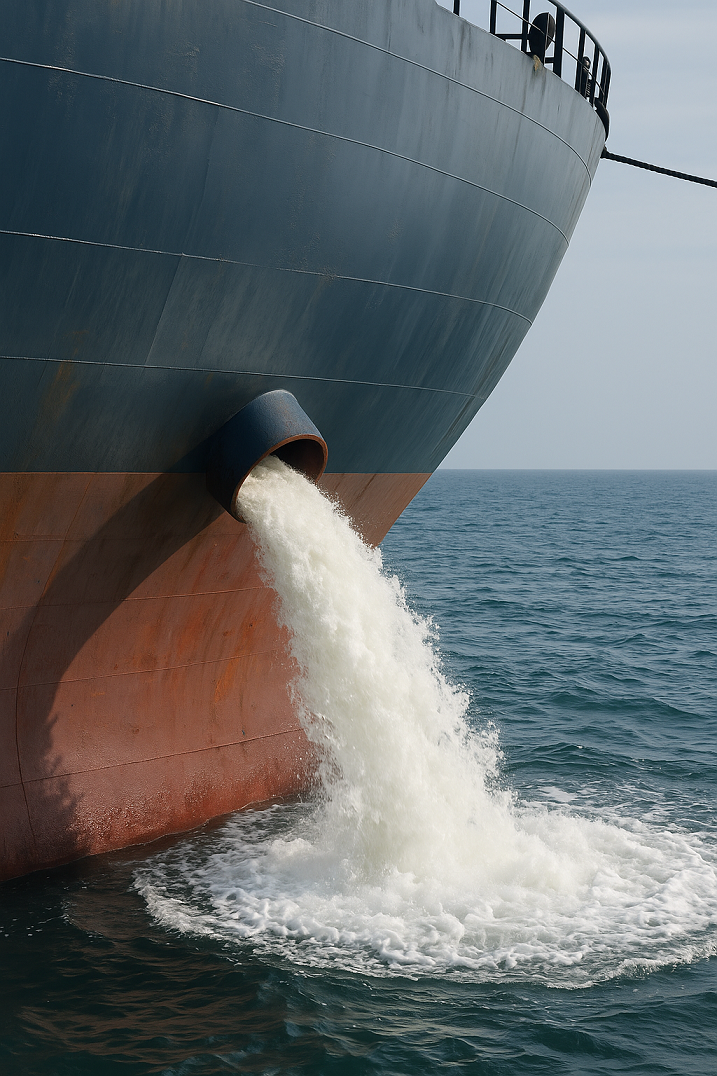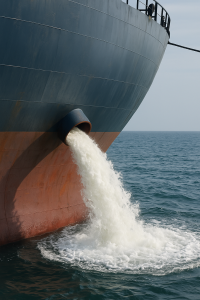Discover the top 12 ballast water compliance guidelines under the BWM Convention. Learn how global regulations protect marine ecosystems and what shipowners must do to stay compliant.
Why Ballast Water Compliance Is a Global Responsibility
In 1988, a microscopic invader from the Black Sea—Mnemiopsis leidyi, a comb jelly—devastated fish populations in the Caspian and the Mediterranean. How did it get there? Through ballast water discharged by transoceanic ships. This is just one of many examples where an invisible threat traveled thousands of miles aboard vessels and wreaked ecological and economic havoc.
To stop this silent invasion, the International Maritime Organization (IMO) introduced the Ballast Water Management (BWM) Convention. It came into force in 2017 after years of scientific collaboration and regulatory debate. As of 2025, the Convention is binding on over 95% of the world’s shipping tonnage.
This article breaks down the Top 12 Compliance Guidelines every ship operator, manager, and marine environmental officer should understand to stay aligned with the BWM Convention. Whether you’re preparing for a Port State Control inspection or selecting a treatment system, these rules are your compass for responsible operations at sea.
Understanding the BWM Convention and Its Objectives
The BWM Convention, officially known as the International Convention for the Control and Management of Ships’ Ballast Water and Sediments, 2004, is the global legal framework that regulates how ships manage and discharge ballast water.
Its primary goal is to prevent the spread of harmful aquatic organisms and pathogens by:
-
Reducing ballast water exchanges in sensitive ecosystems.
-
Ensuring biological treatment of water before discharge.
-
Promoting uniform enforcement across flag and port states.
According to the IMO, invasive species transported by ships are responsible for over $100 billion annually in ecological damage worldwide. The Convention’s importance cannot be overstated.
1. Install and Operate an Approved Ballast Water Management System (BWMS)
Ships of 400 GT and above must be fitted with an IMO-approved BWMS, capable of treating ballast water to meet the D-2 discharge standard.
Key features:
-
Must neutralize or remove organisms ≥10 µm to <50 µm to fewer than 10 viable organisms per mL.
-
Systems must be certified by an Administration or Classification Society, such as DNV or ABS.
-
Treatment methods include ultraviolet (UV) light, electrochlorination, ozone, filtration, or combinations.
Recent advancements:
Manufacturers like Alfa Laval and Wärtsilä have launched modular, energy-efficient systems like PureBallast 3.2 and Aquamaster to reduce footprint and energy use.
2. Maintain a Ballast Water Record Book (BWRB)
Every operation involving ballast water—intake, treatment, circulation, discharge—must be logged in the Ballast Water Record Book.
It should include:
-
Date, time, volume, and location of ballast operations.
-
BWMS operational status.
-
Crew signatures and officer verification.
Failure to maintain accurate logs is a top deficiency noted by Port State Control (Paris MoU and Tokyo MoU) inspections.
3. Comply with the D-2 Discharge Standard
The D-2 standard sets biological thresholds for living organisms in discharged ballast water. These are:
-
Less than 10 viable organisms per m³ for ≥50 µm.
-
Less than 10 viable organisms per mL for ≥10 µm to <50 µm.
-
Specific limits for indicator microbes like E. coli and Vibrio cholerae.
This requirement replaced the older D-1 standard (open-ocean exchange) by September 2024, making full D-2 compliance mandatory.
DNV – BWM D-2 Compliance Guide
4. Obtain the International Ballast Water Management Certificate (IBWMC)
Every vessel over 400 GT on international voyages must carry a valid IBWMC, issued by the flag administration or authorized Classification Society.
To qualify:
-
The ship must have a BWM Plan, a certified BWMS, and a completed survey.
-
Certificates remain valid for five years with annual and intermediate verifications.
Failure to present a valid certificate can result in detention, fines, or denied port entry.
5. Implement an Approved Ballast Water Management Plan (BWMP)
This onboard document explains how ballast water is managed in compliance with the Convention. It is ship-specific and must be:
-
Approved by the flag administration.
-
Updated when BWMS changes.
-
Available in English or working language of the ship.
Plans must include contingency procedures, crew training protocols, sediment management instructions, and operational flowcharts.
6. Conduct Regular BWMS Testing and Calibration
IMO and flag states require shipowners to ensure that BWMS is tested, calibrated, and maintained regularly.
Requirements:
-
Sensors must be tested before each voyage.
-
UV intensity, TRO (Total Residual Oxidants), and flow rates must be logged.
-
Records must be maintained for minimum two years.
Third-party sampling (e.g., by Lloyd’s Register, ClassNK) is increasingly common in port inspections and environmental audits.
7. Train Crew on Ballast Water Management Procedures
The BWM Convention mandates that crew members involved in ballast operations are adequately trained and understand the BWMP.
Training may include:
-
Familiarization with system operation, alarms, and emergency shutdowns.
-
Procedures for logging, testing, and reporting.
-
Scenario-based drills and IMO Model Course 1.38 application.
IMO encourages onboard drills, simulator training, and online learning modules.
8. Follow Port State Control Requirements and Reporting
Many port states now require pre-arrival reporting of ballast operations and system status via electronic forms.
Examples:
-
US Coast Guard (USCG) requires submission 24 hours before arrival.
-
Transport Canada and AMSA conduct random testing for compliance.
-
Ports may demand real-time sampling using indicative and detailed analysis kits.
Transparency and good recordkeeping reduce delays and inspection risks.
9. Manage and Dispose of Ballast Tank Sediments
Sediments accumulate over time and may harbor invasive species. The Convention requires:
-
Sediments to be removed and disposed of at port reception facilities.
-
Records of cleaning operations logged in the BWRB.
-
Crew to wear appropriate PPE and follow tank entry protocols under SOLAS Chapter IX.
IMO encourages the use of sediment sampling protocols during BWMS installation and dry dock surveys.
10. Operate in Accordance with Local and Regional Requirements
In addition to the IMO Convention, vessels must comply with stricter national or regional ballast water laws.
Notable examples:
-
USCG has its own BWMS type approval process, separate from IMO.
-
The European Union, China, and Australia have regional guidance that complements (and sometimes exceeds) BWM Convention rules.
-
Failure to understand overlapping frameworks can result in fines or ship delays.
Tools like Lloyd’s List Intelligence’s compliance navigator or BIMCO’s BWM compliance guides help bridge regulatory gaps.
11. Maintain System Manuals and Spare Parts Onboard
SOLAS and the BWM Convention require vessels to keep system operation manuals, drawings, and critical spare parts onboard.
The absence of:
-
Control panel diagrams.
-
Chemical dosing charts.
-
UV lamp or filter cartridge replacements.
…can be flagged during inspections and impair emergency response capability.
Manufacturers like Ecochlor and OceanSaver provide digital manuals and QR code-based troubleshooting onboard apps.
12. Prepare for Contingency Measures and System Failures
If the BWMS malfunctions or is deemed inoperable, ships must follow contingency plans that include:
-
Holding ballast water until it can be treated or discharged legally.
-
Notifying the flag and port state with an explanation and corrective actions.
-
Coordinating with approved port reception facilities if emergency offloading is required.
As per IMO Circular BWM.2/Circ.62, non-penal actions may apply if the crew responds promptly and transparently.
–
Real-World Example: Compliance in Action
In 2022, a chemical tanker entering Rotterdam underwent a random ballast water sampling. Using an indicative analysis tool, inspectors detected levels above D-2 standards. However, the ship’s crew presented:
-
A valid IBWMC,
-
Digital BWMP access,
-
Calibrated sensors,
-
A logged equipment malfunction with corrective steps.
Because of this proactive transparency, the vessel was not detained, highlighting the importance of operational readiness and documentation.
FAQ: Ballast Water Compliance Questions Answered
Q1: Is D-1 ballast exchange still allowed?
Only for ships not yet fitted with a BWMS. As of September 2024, all ships must meet the D-2 standard.
Q2: Do all ships need a BWMS?
Ships over 400 GT must have an approved BWMS unless exempted for specific routes (same origin and destination without mixing ballast).
Q3: Who issues the Ballast Water Certificate?
Your flag administration or an authorized classification society (e.g., DNV, ClassNK, RINA).
Q4: What is the difference between indicative and detailed sampling?
Indicative sampling is fast and used for routine checks. Detailed analysis uses laboratory methods and is more accurate, typically used for enforcement.
Q5: Can a port deny entry based on BWMS failure?
Yes, especially in environmentally sensitive areas like Australia’s Great Barrier Reef or California ports.
Conclusion: Protecting Oceans, One Drop at a Time
The Ballast Water Management Convention isn’t just about compliance—it’s about preserving the planet’s marine biodiversity. Invasive species don’t need passports, and their effects can be permanent. By following these 12 guidelines, shipowners and crews can not only avoid penalties but also contribute to a cleaner, safer maritime future.
Whether you sail bulk carriers or cruise liners, managing ballast responsibly is no longer optional—it’s part of what it means to be a modern mariner.
References
-
International Maritime Organization. (n.d.). Ballast Water Management
-
DNV. (2024). Ballast Water Compliance Resources
-
USCG. (2024). Ballast Water Compliance and Enforcement
-
ABS. (2023). BWMS Operation and Inspection Guide
-
BIMCO. (2023). Practical Guide to Ballast Water Compliance
-
Paris MoU. (2023). Inspection Results Annual Report
-
Alfa Laval. (2023). PureBallast System Information
-
Wärtsilä. (2023). Ballast Water Management Products


